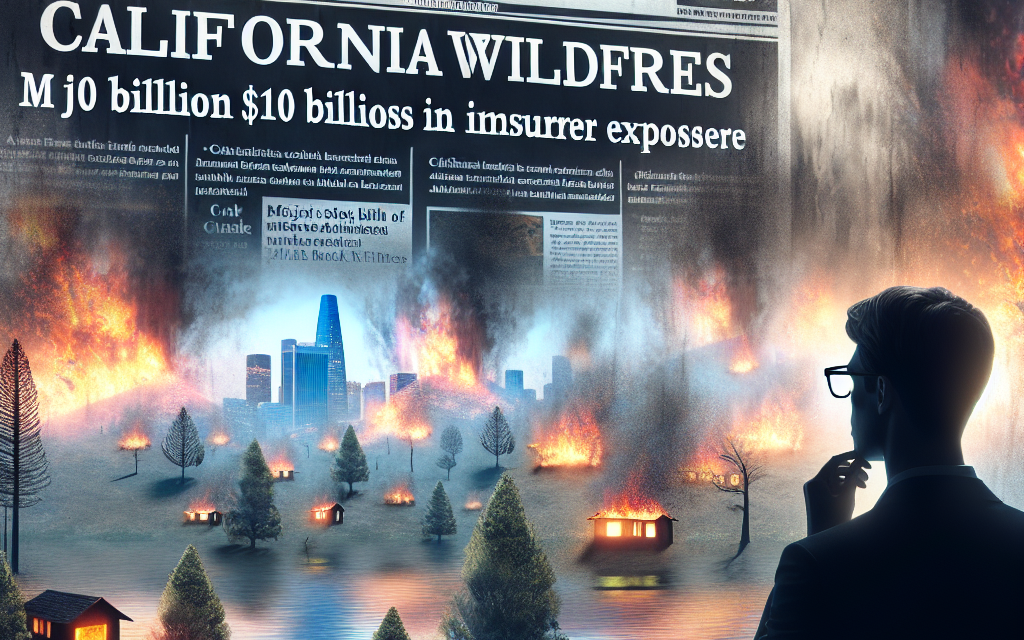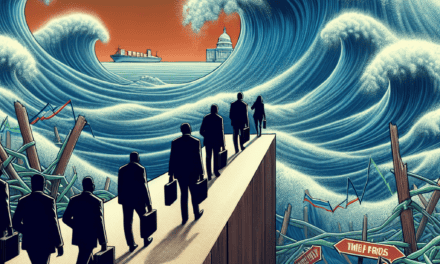“California Wildfires: JPMorgan Estimates $10 Billion in Insured Losses, Highlighting Growing Insurer Exposure.”
Introduction
California wildfires have become a recurring and devastating phenomenon, significantly impacting the state’s environment, economy, and communities. As climate change intensifies and drought conditions persist, the frequency and severity of these wildfires have escalated, leading to catastrophic destruction of property and natural resources. Recent analyses, including a report from JPMorgan, estimate that the financial toll of these wildfires could reach $10 billion in insured losses, highlighting the substantial exposure faced by insurers. This situation underscores the urgent need for effective risk management strategies and policy interventions to mitigate the impact of future wildfires on both the insurance industry and affected communities.
California Wildfires: An Overview of Recent Trends
California has long been synonymous with wildfires, a natural phenomenon exacerbated by climate change, urban development, and prolonged drought conditions. In recent years, the frequency and intensity of these wildfires have escalated, leading to devastating consequences for both the environment and the economy. As the state grapples with the aftermath of these disasters, financial institutions are beginning to assess the impact on the insurance industry. Notably, JPMorgan has projected that the recent wildfires could result in insured losses amounting to $10 billion, highlighting the significant exposure faced by insurers in the region.
The trend of increasing wildfire activity in California is alarming. According to data from the California Department of Forestry and Fire Protection, the state has experienced a marked rise in the number of acres burned each year. This trend is not merely a statistical anomaly; it reflects a broader pattern of climate change that has led to hotter temperatures, drier conditions, and an extended fire season. The implications of these changes are profound, affecting not only the natural landscape but also the communities that inhabit these areas. As wildfires become more frequent, the risk to homes, businesses, and infrastructure escalates, prompting insurers to reevaluate their risk models and coverage options.
In light of these developments, the insurance industry is facing unprecedented challenges. The projected $10 billion in insured losses underscores the financial strain that wildfires impose on insurers. This figure is not just a reflection of the immediate damage caused by the fires; it also encompasses the long-term implications of increased claims, rising premiums, and potential insolvencies among smaller insurance providers. As insurers grapple with these challenges, they are compelled to adopt more stringent underwriting practices and reassess their exposure to high-risk areas. This shift may lead to a tightening of coverage options for homeowners and businesses in fire-prone regions, further complicating the recovery process for affected communities.
Moreover, the economic ramifications of these wildfires extend beyond the insurance sector. The destruction of property and infrastructure can lead to significant job losses and economic downturns in local economies. As communities rebuild, the demand for construction materials and labor surges, which can drive up costs and prolong recovery efforts. Additionally, the psychological toll on residents who have lost their homes or businesses cannot be overstated. The emotional and financial stress associated with such losses can have lasting effects on individuals and families, further complicating the recovery process.
In response to these challenges, policymakers and stakeholders are increasingly focused on developing comprehensive strategies to mitigate wildfire risks. This includes investing in fire prevention measures, enhancing emergency response capabilities, and promoting community resilience initiatives. By addressing the root causes of wildfires and implementing proactive measures, California can work towards reducing the frequency and severity of these disasters in the future.
In conclusion, the recent trends in California wildfires present a complex interplay of environmental, economic, and social factors. As JPMorgan’s prediction of $10 billion in insured losses illustrates, the implications for the insurance industry are significant, necessitating a reevaluation of risk management strategies. As California continues to confront the realities of climate change and its impact on wildfire activity, a collaborative approach involving insurers, policymakers, and communities will be essential in fostering resilience and ensuring a sustainable future. The path forward will require innovation, investment, and a commitment to addressing the challenges posed by wildfires in a rapidly changing world.
Financial Impact: JPMorgan’s $10 Billion Prediction
California wildfires have become an increasingly frequent and devastating occurrence, prompting significant concern not only for the environment and local communities but also for the financial sector. In a recent analysis, JPMorgan has projected that the insured losses from these wildfires could reach a staggering $10 billion. This prediction underscores the growing financial impact of natural disasters on the insurance industry and the broader economy. As wildfires rage across the state, the implications for insurers and policyholders alike are profound.
The prediction of $10 billion in insured losses reflects a combination of factors, including the increasing intensity and frequency of wildfires, which have been exacerbated by climate change. As temperatures rise and drought conditions persist, the risk of wildfires escalates, leading to more extensive damage to homes, businesses, and infrastructure. Consequently, insurers are faced with mounting claims that can significantly affect their financial stability. The scale of these losses not only impacts the insurers directly involved but also reverberates throughout the financial system, as reinsurance markets and investment portfolios are affected.
Moreover, the exposure of insurers to these catastrophic events raises questions about their underwriting practices and risk management strategies. As the frequency of wildfires increases, insurers may need to reassess their coverage policies and pricing models to ensure they remain viable in the face of escalating claims. This reassessment could lead to higher premiums for policyholders, particularly in high-risk areas, which may further strain the relationship between insurers and consumers. The potential for increased costs could also drive some homeowners to forgo insurance altogether, leaving them vulnerable to the financial repercussions of future disasters.
In addition to the immediate financial implications, the broader economic impact of these wildfires cannot be overlooked. The destruction of property and infrastructure not only leads to direct losses for insurers but also affects local economies. Businesses may be forced to close, and communities may face long-term challenges in recovery and rebuilding. This economic disruption can lead to a decrease in property values, further complicating the financial landscape for insurers and homeowners alike. As such, the $10 billion prediction serves as a stark reminder of the interconnectedness of environmental events and economic stability.
Furthermore, the increasing severity of wildfires has prompted discussions about the role of government and public policy in addressing these challenges. As the financial burden of wildfires grows, there is a pressing need for comprehensive strategies that encompass prevention, mitigation, and recovery efforts. Policymakers may need to consider innovative solutions, such as investing in fire prevention programs, enhancing building codes, and promoting community resilience initiatives. By taking proactive measures, it may be possible to reduce the overall financial impact of wildfires and protect both insurers and policyholders from the worst effects of these disasters.
In conclusion, JPMorgan’s prediction of $10 billion in insured losses from California wildfires highlights the urgent need for a multifaceted approach to address the financial implications of these increasingly common events. As the insurance industry grapples with the challenges posed by climate change and natural disasters, it is essential for stakeholders to collaborate on solutions that promote resilience and sustainability. The path forward will require a concerted effort from insurers, policymakers, and communities to navigate the complexities of wildfire risk and its financial ramifications.
Insurer Exposure: Understanding the Risks
California wildfires have become an increasingly frequent and devastating occurrence, posing significant risks not only to the environment but also to the insurance industry. As JPMorgan recently projected, the financial implications of these wildfires could lead to insured losses amounting to $10 billion, highlighting the urgent need to understand insurer exposure in this context. Insurer exposure refers to the potential financial liability that insurance companies face when they underwrite policies in areas prone to natural disasters, such as wildfires. This exposure is particularly concerning in California, where the combination of dry conditions, high winds, and dense vegetation creates a perfect storm for wildfires.
To comprehend the risks associated with insurer exposure, it is essential to consider the factors that contribute to the increasing frequency and severity of wildfires. Climate change plays a pivotal role, as rising temperatures and prolonged droughts create an environment conducive to wildfires. Additionally, urban development in fire-prone areas has intensified the risk, as more homes and businesses are built in regions that were once largely untouched by human activity. Consequently, insurers find themselves grappling with the challenge of accurately assessing risk in these volatile environments.
Moreover, the financial implications of wildfires extend beyond immediate property damage. Insurers must also account for the potential for business interruption claims, as companies may face significant losses during periods of evacuation or when their operations are disrupted by fire-related damage. This multifaceted nature of risk complicates the underwriting process, as insurers strive to balance the need to provide coverage with the imperative to maintain financial stability. As a result, many insurers are reevaluating their exposure in high-risk areas, leading to increased premiums and, in some cases, the withdrawal of coverage altogether.
In light of these challenges, it is crucial for insurers to adopt a proactive approach to risk management. This includes investing in advanced modeling techniques that can better predict wildfire behavior and potential losses. By leveraging technology and data analytics, insurers can enhance their understanding of risk and make more informed decisions regarding policy underwriting and pricing. Furthermore, collaboration with state and local governments can facilitate the development of mitigation strategies aimed at reducing the likelihood and impact of wildfires. Such initiatives may include controlled burns, vegetation management, and improved building codes that promote fire-resistant construction.
As the frequency of wildfires continues to rise, the insurance industry must also grapple with regulatory pressures and public expectations. Policymakers are increasingly scrutinizing the practices of insurers, particularly in terms of their ability to provide coverage in high-risk areas. This scrutiny may lead to calls for greater transparency in how insurers assess risk and set premiums, as well as demands for more equitable access to coverage for homeowners in fire-prone regions. Insurers must navigate this complex landscape while remaining responsive to the needs of their policyholders.
In conclusion, understanding insurer exposure in the context of California wildfires is essential for both the insurance industry and the communities it serves. As JPMorgan’s prediction of $10 billion in insured losses underscores, the financial stakes are high. By adopting innovative risk management strategies and engaging with stakeholders, insurers can better position themselves to navigate the challenges posed by wildfires, ultimately ensuring their sustainability and the protection of their policyholders. The path forward will require a concerted effort to balance risk, affordability, and accessibility in an increasingly unpredictable environment.
Climate Change and Its Role in Wildfire Severity
California wildfires have become an increasingly frequent and devastating phenomenon, with climate change playing a pivotal role in exacerbating their severity. As temperatures rise and weather patterns shift, the conditions that fuel these catastrophic events are becoming more pronounced. The interplay between climate change and wildfire dynamics is complex, yet it is essential to understand how these factors contribute to the growing risk of destruction and loss.
One of the primary ways climate change influences wildfire severity is through elevated temperatures. Over the past few decades, California has experienced a significant increase in average temperatures, which has led to drier conditions across the state. This drying effect not only reduces the moisture content in vegetation but also creates an environment where wildfires can ignite more easily and spread rapidly. As a result, the fire season has lengthened, with wildfires now occurring earlier in the year and lasting longer than in previous decades. This extended fire season places additional strain on firefighting resources and increases the likelihood of widespread damage.
Moreover, climate change has been linked to altered precipitation patterns, which further complicate the wildfire landscape. While some regions may experience intense rainfall, others face prolonged droughts. These fluctuations can lead to a build-up of dry vegetation during drought periods, which serves as ample fuel for wildfires when ignited. Conversely, heavy rains can result in an abundance of vegetation growth, creating a lush environment that, when dried out, becomes highly flammable. This cyclical nature of precipitation and vegetation growth underscores the unpredictable and often dangerous conditions that climate change fosters.
In addition to temperature and precipitation changes, climate change also contributes to the increasing frequency and intensity of extreme weather events. For instance, strong winds, which are often associated with heat waves and dry conditions, can exacerbate wildfire spread. These winds can carry embers over long distances, igniting new fires and complicating containment efforts. The combination of high temperatures, dry vegetation, and strong winds creates a perfect storm for wildfires, leading to more severe and destructive incidents.
The implications of these intensified wildfires extend beyond immediate destruction; they also pose significant challenges for insurers. As JPMorgan recently predicted, the financial impact of California wildfires could reach $10 billion in insured losses, highlighting the growing exposure that insurers face in the wake of climate change. This financial burden is not only a concern for insurance companies but also for homeowners and businesses that rely on coverage to recover from losses. As the frequency and severity of wildfires increase, insurers may be compelled to adjust their risk models, potentially leading to higher premiums and reduced coverage options for policyholders.
Furthermore, the economic ramifications of wildfires extend to local communities and the broader economy. The destruction of homes, businesses, and infrastructure can lead to long-term economic challenges, including job losses and decreased property values. As communities grapple with the aftermath of wildfires, the need for effective disaster response and recovery strategies becomes increasingly critical.
In conclusion, the relationship between climate change and wildfire severity is a pressing concern that demands attention. As California continues to face the realities of a changing climate, understanding the factors that contribute to wildfire risk is essential for developing effective mitigation strategies. The financial implications for insurers and the broader economic impact on communities underscore the urgency of addressing climate change and its role in shaping the future of wildfire management.
Mitigation Strategies for Insurers in Wildfire-Prone Areas
As California continues to grapple with the devastating impact of wildfires, the financial implications for insurers are becoming increasingly pronounced. With JPMorgan predicting insured losses to reach $10 billion, it is imperative for insurers operating in wildfire-prone areas to adopt effective mitigation strategies. These strategies not only aim to reduce potential losses but also enhance the resilience of communities at risk.
One of the foremost strategies involves the implementation of advanced risk assessment models. By utilizing sophisticated data analytics and geographic information systems, insurers can better understand the specific risks associated with different regions. This approach allows for a more accurate pricing of premiums and the identification of high-risk areas that may require additional underwriting scrutiny. Furthermore, these models can help insurers to forecast potential losses more effectively, enabling them to allocate resources and capital more judiciously.
In addition to improved risk assessment, insurers are increasingly collaborating with local governments and communities to promote fire prevention initiatives. This partnership can take various forms, including funding for controlled burns, vegetation management, and the creation of defensible spaces around properties. By investing in these proactive measures, insurers not only contribute to the safety of their policyholders but also mitigate their own exposure to catastrophic losses. Such collaborations can foster a sense of shared responsibility, encouraging communities to take an active role in fire prevention.
Moreover, insurers are exploring innovative policy structures that incentivize policyholders to adopt fire-resistant measures. For instance, offering premium discounts for homeowners who install fire-resistant roofing, create defensible spaces, or utilize fire-resistant landscaping can motivate individuals to invest in their property’s safety. This not only reduces the likelihood of claims but also cultivates a culture of preparedness among policyholders. By aligning financial incentives with risk reduction, insurers can create a win-win scenario that benefits both parties.
Another critical aspect of mitigation strategies involves the use of technology. The integration of smart home technologies, such as fire detection systems and automated sprinkler systems, can significantly enhance a property’s resilience to wildfires. Insurers can encourage the adoption of these technologies through premium reductions or rebates, thereby promoting a proactive approach to risk management. Additionally, the use of drones and satellite imagery can assist insurers in monitoring wildfire risks in real-time, allowing for timely interventions and more informed decision-making.
Furthermore, education plays a vital role in mitigating wildfire risks. Insurers can take the lead in providing resources and information to policyholders about best practices for fire safety and preparedness. Workshops, webinars, and informational materials can empower homeowners to take necessary precautions, ultimately reducing the likelihood of devastating losses. By fostering a well-informed customer base, insurers can enhance their overall risk management strategies.
In conclusion, as California faces the ongoing threat of wildfires, insurers must adopt comprehensive mitigation strategies to navigate the complexities of this perilous landscape. By leveraging advanced risk assessment models, collaborating with communities, incentivizing fire-resistant measures, embracing technology, and prioritizing education, insurers can significantly reduce their exposure to losses. Ultimately, these proactive measures not only protect the financial interests of insurers but also contribute to the safety and resilience of the communities they serve. As the landscape of wildfire risk continues to evolve, the importance of these strategies will only grow, underscoring the need for a concerted effort in wildfire mitigation.
The Economic Ripple Effect of Wildfires on Local Communities
The recent predictions by JPMorgan regarding the California wildfires highlight a staggering potential of $10 billion in insured losses, underscoring the profound economic ripple effect these disasters have on local communities. As wildfires become increasingly frequent and intense, the implications extend far beyond the immediate destruction of property and loss of life. The economic ramifications touch various sectors, influencing everything from local businesses to housing markets and public services.
When wildfires devastate a region, the immediate impact is often seen in the destruction of homes and businesses. Local economies, which rely heavily on small businesses, face significant challenges as storefronts are damaged or destroyed. This disruption not only affects the owners but also the employees who depend on these jobs for their livelihoods. As businesses close or reduce their operations, the unemployment rate in the affected areas can rise sharply, leading to decreased consumer spending and further economic stagnation. Consequently, the local economy may struggle to recover, creating a cycle of hardship that can last for years.
Moreover, the destruction of infrastructure, such as roads, schools, and hospitals, exacerbates the situation. The cost of rebuilding these essential services can be astronomical, often requiring significant investment from both local and state governments. This financial burden can divert funds from other critical areas, such as education and public safety, thereby impacting the overall quality of life for residents. As communities grapple with the aftermath of wildfires, the strain on public resources can lead to a decline in services that residents rely on daily.
In addition to the immediate economic impacts, wildfires can also influence the housing market. As properties are destroyed, the demand for housing can shift dramatically. In some cases, this may lead to a temporary increase in housing prices due to a limited supply of available homes. However, as the long-term effects of the disaster set in, potential buyers may be deterred by the risks associated with living in fire-prone areas. This hesitance can lead to a decline in property values, further complicating the recovery process for homeowners and local governments alike.
Furthermore, the psychological toll on residents cannot be overlooked. The trauma associated with losing a home or witnessing the destruction of a community can lead to long-term mental health issues. As residents struggle to cope with their losses, the demand for mental health services may increase, placing additional strain on local resources. This aspect of recovery is often overlooked in discussions about economic impacts, yet it is crucial for understanding the full scope of the challenges faced by affected communities.
As JPMorgan’s predictions illustrate, the financial exposure for insurers is significant, but the broader economic implications for local communities are equally concerning. The interplay between insured losses and the economic health of a region highlights the need for comprehensive disaster preparedness and recovery strategies. By investing in fire prevention measures and supporting local businesses, communities can build resilience against future wildfires. Ultimately, addressing the economic ripple effect of wildfires requires a multifaceted approach that considers not only immediate financial losses but also the long-term recovery and well-being of affected residents. As California continues to face the threat of wildfires, understanding these dynamics will be essential for fostering sustainable recovery and ensuring that communities can thrive in the face of adversity.
Future Outlook: Preparing for Increasing Wildfire Incidences
As California continues to grapple with the devastating impact of wildfires, the future outlook for the state’s insurance landscape is becoming increasingly concerning. Recent predictions from JPMorgan indicate that insured losses could reach a staggering $10 billion, highlighting the urgent need for both insurers and policyholders to prepare for the escalating frequency and intensity of these natural disasters. The implications of such losses extend beyond immediate financial concerns; they also signal a shift in how insurance companies assess risk and manage exposure in wildfire-prone regions.
In light of these predictions, it is essential for insurers to reevaluate their underwriting practices. Traditional models may no longer suffice in accurately predicting the likelihood of wildfire occurrences, given the changing climate and its associated effects. As temperatures rise and drought conditions become more prevalent, the risk of wildfires is expected to increase, necessitating a more dynamic approach to risk assessment. Insurers must invest in advanced analytics and data-driven models that incorporate real-time environmental factors, historical data, and predictive algorithms to better understand and mitigate their exposure to wildfire-related claims.
Moreover, the role of technology in wildfire management cannot be overstated. Innovations such as satellite imagery, drones, and artificial intelligence can provide critical insights into fire behavior and potential risk areas. By leveraging these technologies, insurers can enhance their risk mitigation strategies, allowing them to identify high-risk properties and implement preventative measures. This proactive approach not only helps insurers manage their exposure but also empowers policyholders to take necessary precautions to protect their homes and businesses.
For homeowners and businesses in wildfire-prone areas, understanding the evolving landscape of insurance coverage is paramount. As insurers adjust their policies in response to increasing risks, policyholders may face higher premiums or stricter coverage limitations. It is crucial for individuals to stay informed about their insurance options and to engage in open discussions with their insurers about coverage specifics. Additionally, investing in fire-resistant materials and implementing defensible space practices can significantly reduce the risk of property damage, potentially leading to lower insurance costs and better coverage terms.
Furthermore, community engagement plays a vital role in wildfire preparedness. Local governments and organizations can collaborate with insurers to develop comprehensive wildfire mitigation plans that address both prevention and recovery. By fostering community awareness and encouraging residents to participate in fire safety programs, communities can collectively reduce their vulnerability to wildfires. This collaborative approach not only enhances individual preparedness but also strengthens the overall resilience of the community.
As California faces an uncertain future marked by increasing wildfire incidences, the need for a multifaceted strategy becomes evident. Insurers must adapt their practices to reflect the changing risk landscape, while policyholders should remain proactive in safeguarding their properties. By embracing technology, fostering community engagement, and prioritizing risk management, both insurers and policyholders can navigate the challenges posed by wildfires more effectively. Ultimately, a concerted effort to prepare for the future will be essential in mitigating the impact of wildfires and ensuring the sustainability of the insurance market in California. As the state continues to confront the realities of climate change, the lessons learned from past wildfires will be invaluable in shaping a more resilient future.
Q&A
1. **What is the estimated insured loss from California wildfires according to JPMorgan?**
$10 billion.
2. **What factors contribute to the high insured losses from wildfires in California?**
Factors include the increasing frequency and intensity of wildfires, rising property values, and the expansion of residential areas into fire-prone regions.
3. **Which insurers are most exposed to the risks associated with California wildfires?**
Insurers with significant market share in California, particularly those specializing in homeowners and property insurance, are most exposed.
4. **How do wildfires impact the insurance market in California?**
Wildfires lead to increased claims, higher premiums, and potential market withdrawals by insurers due to unsustainable risk levels.
5. **What measures are being taken to mitigate wildfire risks in California?**
Measures include improved forest management, community preparedness programs, and stricter building codes in fire-prone areas.
6. **How does climate change influence the frequency of wildfires in California?**
Climate change contributes to hotter temperatures, prolonged droughts, and changing precipitation patterns, all of which increase wildfire risk.
7. **What role does technology play in wildfire management and insurance?**
Technology aids in risk assessment, real-time monitoring of fire conditions, and predictive modeling to improve underwriting and claims processes.
Conclusion
The prediction of $10 billion in insured losses from California wildfires by JPMorgan highlights the significant financial impact of these natural disasters on the insurance industry. As wildfires become more frequent and severe due to climate change, insurers face increasing exposure, which may lead to higher premiums and potential market adjustments. This situation underscores the urgent need for improved risk management strategies and investment in wildfire prevention and mitigation efforts to protect both communities and the insurance sector.





